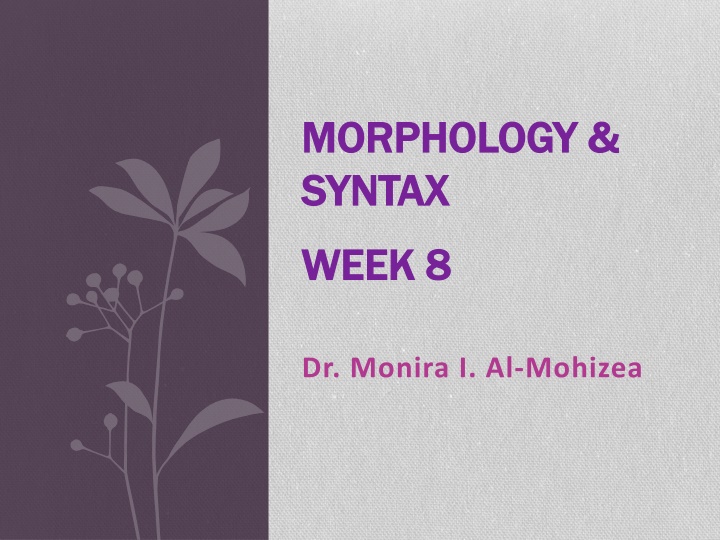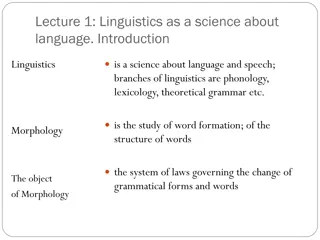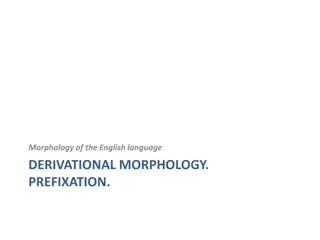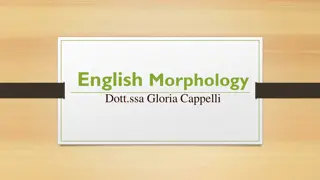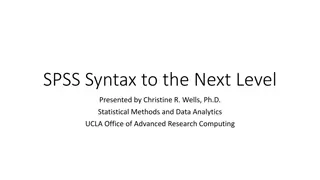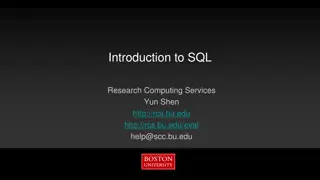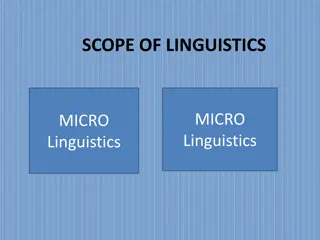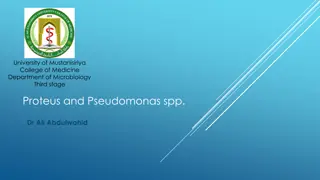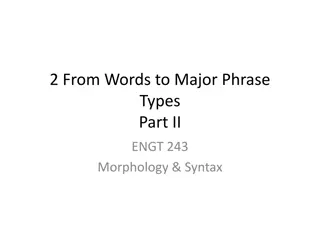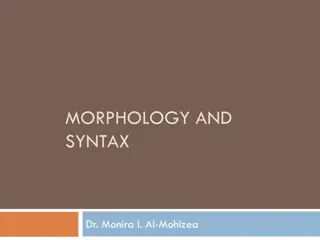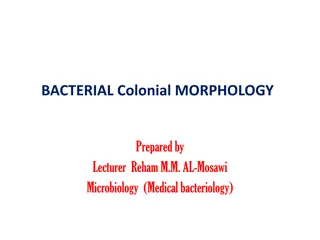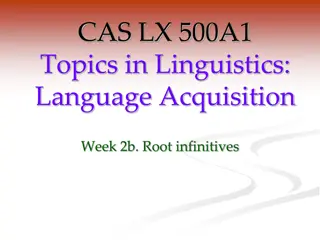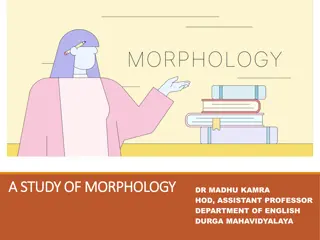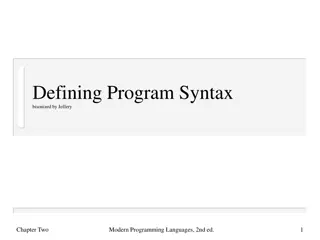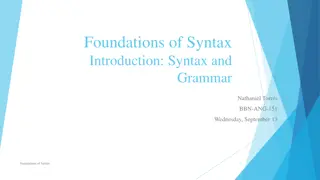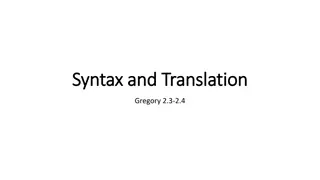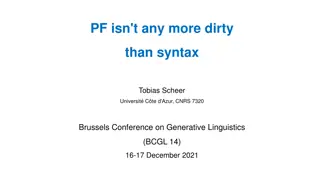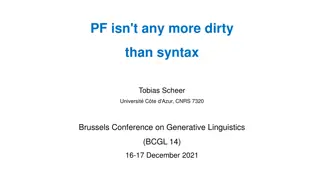MORPHOLOGY & SYNTAX
Delve into the intricate relationship between form, function, and meaning in morphology and syntax. Understand why function takes precedence over form and meaning, with examples illustrating the complexities of word classes and suffix usage. Explore the nuances of inflection tests and the importance of form in determining word properties. Dive into the challenges posed by suffixes, highlighting how they can sometimes mislead in identifying word classes.
Download Presentation

Please find below an Image/Link to download the presentation.
The content on the website is provided AS IS for your information and personal use only. It may not be sold, licensed, or shared on other websites without obtaining consent from the author.If you encounter any issues during the download, it is possible that the publisher has removed the file from their server.
You are allowed to download the files provided on this website for personal or commercial use, subject to the condition that they are used lawfully. All files are the property of their respective owners.
The content on the website is provided AS IS for your information and personal use only. It may not be sold, licensed, or shared on other websites without obtaining consent from the author.
E N D
Presentation Transcript
MORPHOLOGY & MORPHOLOGY & SYNTAX SYNTAX WEEK 8 WEEK 8 Dr. Monira I. Al-Mohizea
Form, Function & meaning Form, Function & meaning The three tests can be placed in the following order of The three tests can be placed in the following order of importance: importance: 1. 1. Function is most important Function is most important 2. 2. Form is next most important Form is next most important 3. 3. Meaning is least important Meaning is least important WHY? DISCUSS..
Why.. Why.. 1. 1. meaning is not a reliable guide to word class meaning is not a reliable guide to word class Consider: Consider: I love I love (v.) (v.) my country, but my love my country, but my love (n.) Love (v.) and love (n.) have the same meaning, both refer to Love (v.) and love (n.) have the same meaning, both refer to a particular a particular emotion emotion, but they differ in , but they differ in word class 2. 2. we cannot always rely on a word's form, because many we cannot always rely on a word's form, because many words contain no suffix words contain no suffix E.g E.g. help, water, much, rather . help, water, much, rather), and words (e.g. quite quite) are ) are invariable, invariable, i.e. they do not change their form by they do not change their form by inflection at all. inflection at all. Sometimes, there is an ambiguous use of suffixes; Sometimes, there is an ambiguous use of suffixes; E.g. E.g. ing ing marks marks three three different word classes. E.g. It was very different word classes. E.g. It was very amus amusing ing (adj.) to w (adj.) to watch the cops try atch the cops trying build building ing (n.). (n.). (n.) of humanity is greater. of humanity is greater. word class. . ), and words (e.g. the, of, too, the, of, too, ing (v.) to break into the (v.) to break into the
Suffixes Suffixes which seem to be which seem to be safe class, may sometimes mislead. class, may sometimes mislead. E.g. E.g. ion ion generally indicates a generally indicates a noun (in e.g. (in e.g. Don't mention it Don't mention it) is a verb. ly ly ending is usually an ending is usually an adverb but there are also a number of adjectives that end but there are also a number of adjectives that end in in ly ly, , (e.g. (e.g. likely, lively and lovely). likely, lively and lovely). Conclusion Conclusion the form of a word in not an infallible guide. the form of a word in not an infallible guide. safe indicators of a word indicators of a word noun, but ment , but mention ) is a verb. adverb suffix, as in suffix, as in quickly ion quickly, ,
Test of inflection Test of inflection Though not fully reliable, the importance of form Though not fully reliable, the importance of form should never be ignored, as it is often should never be ignored, as it is often conclusive E.g. E.g. 1. 1. question question as a verb has inflected forms (e.g. as a verb has inflected forms (e.g. questions, questioned questions, questioned and 2. 2. As a noun, however, As a noun, however, question question has only the plural inflected form ( inflected form (questions) questions). . conclusive. . and questioning questioning). ). has only the plural How do we decide??? How do we decide??? Discuss.. Discuss..
Explanation.. Explanation.. we can decide whether we can decide whether question similar sentences with the inflected forms: similar sentences with the inflected forms: 1. 1. We (always) We (always) question question the usual suspects. 2. 2. We We question questioned ed the usual suspects (yesterday). the usual suspects (yesterday). 3. 3. We are We are question questioning ing the usual suspects (tomorrow). the usual suspects (tomorrow). In [1] question is a In [1] question is a verb verb because [2] and [3) are similar to because [2] and [3) are similar to [1] in [1] in structure structure and and meaning meaning. English has few inflections: . English has few inflections: this inflection test applies mainly only to this inflection test applies mainly only to nouns question is a is a verb verb by coming up with by coming up with the usual suspects. nouns and and verbs verbs. . Conclusion: Conclusion: Because of the limitations of Because of the limitations of form and meaning criteria, we have to rely chiefly on a word's criteria, we have to rely chiefly on a word's function as a criterion of its class. of its class. form and meaning as as a criterion as
The notion function The notion function Function Function (its position or role in the structure of the (its position or role in the structure of the sentence) is the most important criterion for identifying sentence) is the most important criterion for identifying a word's class. a word's class. But But how do we describe function? how do we describe function? Sentences vary in length and structure Sentences vary in length and structure The words in those sentences can occur in many The words in those sentences can occur in many different positions. different positions. Therefore, Therefore, (1) (1) We need to have some notion of how We need to have some notion of how words form pattern in sentences, and for this words form pattern in sentences, and for this (2) need to recognize units intermediate in size need to recognize units intermediate in size (i.e. (i.e. hierarchy of units hierarchy of units). ). (2) we we
A hierarchy of units A hierarchy of units The The sentence sentence is the largest unit of language that we is the largest unit of language that we are concerned with in grammar. are concerned with in grammar. Words are little grammatical units, but to show how Words are little grammatical units, but to show how they pattern in sentences, we need to to recognize they pattern in sentences, we need to to recognize units units intermediate in size intermediate in size between a sentence sentence. . The terms most commonly used for these The terms most commonly used for these intermediate units are intermediate units are phrase phrase and A typical sentence can be composed of a hierarchy of A typical sentence can be composed of a hierarchy of units, one inside another. units, one inside another. between a word word and a and a and clause clause. .
Consider the following: Consider the following: What is the difference between a phrase What is the difference between a phrase and a clause?? and a clause?? Discuss Discuss
A phrase A phrase Definition: Definition: A phrase is a syntactic structure that A phrase is a syntactic structure that contains one or more words contains one or more words but does not contain both a subject and a verb both a subject and a verb (so it is not a sentence). A phrase has A phrase has one one central element, referred to as central element, referred to as the the head head of the phrase. of the phrase. Subject (e.g., Subject (e.g., The boy The boy was very small.) Heads of was very small.) Heads of phrases can be: phrases can be: Noun, verb, adjective, prepositional phrases Noun, verb, adjective, prepositional phrases but does not contain (so it is not a sentence).
A clause A clause Definition: Definition: A clause is a syntactic structure that A clause is a syntactic structure that contains both a subject and a predicate contains both a subject and a predicate. . There are two types of clauses: There are two types of clauses: 1. 1. independent (main) independent (main) 2. 2. dependent (subordinate) dependent (subordinate)
Bracketing system: phrases phrases will be enclosed in round will be enclosed in round brackets brackets ( ) ( ) clauses clauses by enclosing them in square by enclosing them in square brackets brackets [ ] [ ] Each of the four Each of the four NAVA main word of a phrase, which is called after the main word of a phrase, which is called after the word. word. So, there are So, there are noun phrases noun phrases, , adjective phrases verb phrases verb phrases and and adverb phrases adverb phrases. . NAVA word classes can be the word classes can be the adjective phrases, ,
noun, adjective, verb & adverb phrases What is a What is a noun phrases, adjective phrases, verb phrases & adverb phrases?? a noun phrase: a noun phrase: its of the phrase) is a of the phrase) is a noun a verb phrase: a verb phrase: its main word (=head) is a its main word (=head) is a verb an adjective phrase: an adjective phrase: its main word (=head) is an its main word (=head) is an adjective adjective. . an adverb phrase: an adverb phrase: its main word (=head) is an its main word (=head) is an adverb adverb. . its main word (known as the head (known as the head noun. . verb
Consider the following: Consider the following: (my hair) (my hair) (has been growing) (has been growing) (very untidy) (very untidy) (just recently) (just recently) Can we join these (single) phrases into a Can we join these (single) phrases into a single sentence?? single sentence??
Answer Answer We can make these We can make these four phrases joining them in sequence: joining them in sequence: [(My hair) (has been growing) (very untidy) (just recently)]. [(My hair) (has been growing) (very untidy) (just recently)]. = noun phrase + verb phrase + adjective phrase + adverb = noun phrase + verb phrase + adjective phrase + adverb phrase phrase A A unit unit can consist of one or more than one unit of a can consist of one or more than one unit of a lower 'rank' 'rank'. (e.g. a phrase can consist of . (e.g. a phrase can consist of one word than one word. than one word. Compare Compare: : [(Beards) (grow) (untidy) (quickly)] [(Beards) (grow) (untidy) (quickly)] vs. [(My hair) (has been growing) (very untidy) (just recently)] [(My hair) (has been growing) (very untidy) (just recently)] Discuss?? Discuss?? four phrases into a into a single clause single clause by by lower one word or more or more vs.
Tree diagrams, structure of a clause Tree diagrams, structure of a clause
The structure of a clause The structure of a clause
Shout! Shout! Is a clause clause consisting of just consisting of just one [ [(shout) (shout)] ] Is a sentence sentence consisting of just consisting of just one one phrase one phrase. .
Defining Content Words Defining Content Words (NAVA) terms of terms of form, function and form, function and meaning meaning (NAVA) in in
Nouns (1) Function Nouns (1) Function The Class of The Class of nouns nouns is the most numerous word is the most numerous word class. class. Function: Function: Nouns can function as the Nouns can function as the head noun phrase. noun phrase. head of a of a Consider the following & identify nouns: Consider the following & identify nouns: 1. 1. (donkeys) (donkeys) 2. 2. (our town) (our town) 3. 3. (the worst journey ever) (the worst journey ever) 4. 4. (Stanley's historic meeting with Livingstone) (Stanley's historic meeting with Livingstone)
*TEST: *TEST: to recognize a noun phrases try to see to recognize a noun phrases try to see whether a word sequence will fit into a frame such as: whether a word sequence will fit into a frame such as: 1. 1. Have you heard about? Have you heard about? or about? about? 2. 2. It is also possible for a It is also possible for a noun phrase noun phrase to begin with the the . . Try these tests on the four examples above: Try these tests on the four examples above: or How much do you know How much do you know to begin with
Nouns (2) Form Nouns (2) Form Many nouns have Many nouns have characteristic E.g. E.g. - -er er (singer), (singer), - -ism - -ity ity (university), (university), - -ness There are many There are many exceptions endings endings do not signal a noun do not signal a noun. . E.g. E.g. longer longer is ( is (adj adj), ), linger Most nouns can change their Most nouns can change their form plural plural by adding by adding - -s s or dresses). dresses). Or by some other change of form (woman Or by some other change of form (woman - - wom foot foot - - f feet eet). ). characteristic (distinctive) suffixes (distinctive) suffixes ism (fascism), (fascism), - -ion ion or ness (good (good- -ness). ness). exceptions, of course, where these , of course, where these or - -ation ation (caution) (caution) linger is (v.). is (v.). form from from singular es (e.g. goal (e.g. goal - - goals; dress singular to goals; dress - - to or - -es women en; ;
Nouns (3) Meaning Nouns (3) Meaning Nouns typically refer to Nouns typically refer to physical called called concrete nouns concrete nouns: : people (e.g. student), people (e.g. student), objects (e.g. book), objects (e.g. book), places (e.g. city), places (e.g. city), substances (e.g. gold), etc. substances (e.g. gold), etc. there are also there are also abstract nouns , which abstract nouns , which refer to events, states, times, etc. (e.g. birth, happiness, revival, life). states, times, etc. (e.g. birth, happiness, revival, life). Members of such a large class as nouns will not always Members of such a large class as nouns will not always behave similarly. Therefore, we distinguish the various behave similarly. Therefore, we distinguish the various subclasses in terms of subclasses in terms of form, function and meaning form, function and meaning. . physical things, these nouns are things, these nouns are refer to events,
Count/non Count/non- -count nouns count nouns Count nouns Count nouns (e.g., table, dog, idea, mile) refer to things (e.g., table, dog, idea, mile) refer to things that can be counted, and they can have that can be counted, and they can have a plural form (tables, etc.). (tables, etc.). Non Non- -count nouns count nouns (e.g. * (e.g. *golds golds, * substances, qualities, etc., that we do not think of as substances, qualities, etc., that we do not think of as coming in countable 'lumps': coming in countable 'lumps': these nouns normally have these nouns normally have no plural however, the same form can belong to however, the same form can belong to both categories compare compare: : (Her hair is brown) (Her hair is brown) vs. vs. (I found two hairs in my glass) (I found two hairs in my glass) a plural form , *goodnesses goodnesses) refer to ) refer to no plural. . both categories: :
Proper/common/collective nouns Proper/common/collective nouns Proper nouns: Proper nouns: denote an individual person, place, etc. and they denote an individual person, place, etc. and they normally start with a normally start with a capital capital and it generally has no plural form and it generally has no plural form and does not occur after and does not occur after the the , , (e.g. (e.g. John, Africa John, Africa) ) common nouns: common nouns: classify things into types, they can classify things into types, they can occur after the the . . (e.g. time, child and money) (e.g. time, child and money) Collective nouns Collective nouns: These are generally count nouns, but even in : These are generally count nouns, but even in the the singular singular they refer to they refer to groups groups of people (e.g. government, family team). (e.g. government, family team). Grammatically Grammatically, what we notice about collective nouns is this: they can , what we notice about collective nouns is this: they can sometimes go with a sometimes go with a plural plural verb even when they themselves are singular: verb even when they themselves are singular: (e.g. Her family (e.g. Her family live/lives live/lives in Bangalore). in Bangalore). occur after of people, animals or things: , animals or things:
Adjectives (1) Function Adjectives (1) Function Adjectives in general have Adjectives in general have two functions 1. 1. as a as a head ( head (or main word) of an adjective phrase: or main word) of an adjective phrase: E.g. [Dukes can be E.g. [Dukes can be (very rich) (very rich)]. ]. 2. 2. as a modifier in a noun phrase. as a modifier in a noun phrase. E.g. E.g. (a rich duke) (a rich duke). . If a word can fill If a word can fill both both these positions, we can feel these positions, we can feel confident that it is an confident that it is an adjective adjective. . two functions: :
Adjectives (2) Form Adjectives (2) Form Most Most common adjectives common adjectives can have superlative superlative forms: (e.g. rich, richer, richest). forms: (e.g. rich, richer, richest). Thus we can often tell an Thus we can often tell an adjective take take er er and and est est as suffixes. as suffixes. However, longer adjectives do not take However, longer adjectives do not take - -er er and but combine with a separate comparative or but combine with a separate comparative or superlative adverb: more or most. (e.g. more superlative adverb: more or most. (e.g. more beautiful) beautiful) There are also a few irregular adjectives which have There are also a few irregular adjectives which have special comparative and superlative forms, (e.g. special comparative and superlative forms, (e.g. good, better, best). good, better, best). can have comparative comparative and and adjective by its ability to by its ability to and est est, ,
Adjectives (3) Meaning Adjectives (3) Meaning Adjectives typically describe some Adjectives typically describe some quality nouns nouns Most commonly to narrow down, or specify more Most commonly to narrow down, or specify more precisely, the reference of nouns, precisely, the reference of nouns, Consider the following: 1. 1. [(She) (had) (a [(She) (had) (a sympathetic sympathetic face)]. 2. 2. [(Her face) (was) ( [(Her face) (was) (sympathetic sympathetic)] )] Adjectives have various types of meanings: Adjectives have various types of meanings: 1. 1. physical qualities of physical qualities of colour colour, size, shape, etc.: (e.g. green, large, tall, round) green, large, tall, round) 2. 2. psychological qualities of emotion, etc.: (e.g. funny, psychological qualities of emotion, etc.: (e.g. funny, brave, amazing, interested) brave, amazing, interested) 3. 3. evaluative qualities: (e.g. evaluative qualities: (e.g. good, wrong, beautiful, clever clever) ) quality attributed to attributed to Consider the following: face)]. , size, shape, etc.: (e.g. good, wrong, beautiful,
*Test: *Test: a good test of adjectives is to place them a good test of adjectives is to place them after the so after the so- -called called copula verb copula verb to be follow it. follow it. In the frame In the frame Noun Phrase Noun Phrase be as in: [(Her eyes) (were) ( [(Her eyes) (were) (brown brown / / blue enormous)]. enormous)]. to be, as they normally , as they normally be as in: blue / / wary wary / / intelligent intelligent / /
Thank Thank you you
